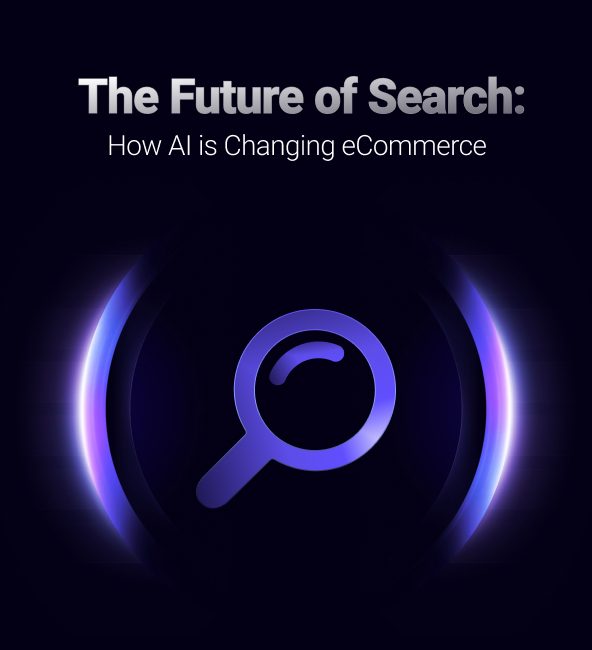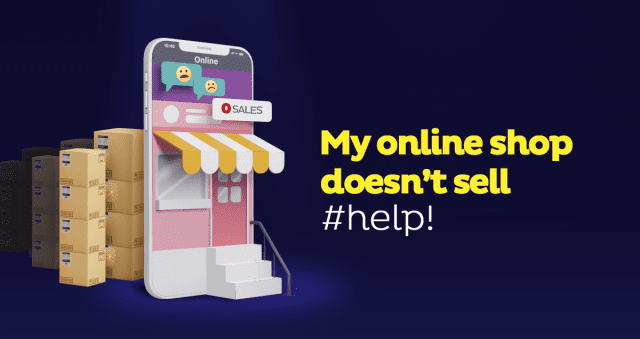Online shopping has come a long way from static product pages and keyword-based search bars. Today’s customers expect more than efficiency — they want interaction, advice, and, most of all, feeling understood. That’s where conversational commerce comes in.
Instead of forcing shoppers to adapt to rigid website structures, conversational commerce allows them to communicate naturally — asking questions, comparing options, and discovering products through dialogue. It’s shopping that feels more like talking to a helpful store assistant than browsing a catalog.
Powered by advances in AI and natural language understanding, this shift is reshaping how people buy and how brands connect. Tools like Doofinder’s AI Assistant are leading the way, turning online stores into spaces that can listen, learn, and respond in real time.
The Definition of Conversational Commerce
Conversational commerce is all about real-time, two-way communication between customers and brands — usually through chat, messaging apps, or voice assistants. It’s what happens when shopping turns into a conversation.
Instead of clicking through endless menus, someone might simply say, “Show me jackets for cold weather,” and the assistant instantly responds with options, prices, and availability. The whole exchange feels more like chatting with a helpful store associate than browsing through a website.
At its heart, conversational commerce brings the warmth and personal touch of an in-store experience to the convenience of online shopping. It helps bridge the gap between what customers say and what they actually mean — guiding them to exactly what they want, faster and with less hassle.

How Conversational Commerce Works
Behind the scenes, conversational commerce is powered by natural language processing (NLP) and artificial intelligence (AI) that work together to understand what a shopper means, not just the exact words they use. These systems interpret intent by analyzing language patterns, context, tone, and even past interactions or purchase history to generate relevant recommendations or responses in real time.
This technology can be embedded across multiple touchpoints — from chat widgets on websites to messaging platforms like WhatsApp or Facebook Messenger, and even voice assistants such as Alexa or Google Assistant. Each channel uses AI-driven models to continuously learn from interactions, improving accuracy and personalization with every conversation.
Why Conversational Commerce Matters
Conversational commerce isn’t just a new channel — it’s reshaping what customers expect and what brands can deliver. Modern shoppers don’t want to dig through filters or menus; they want to be understood and guided. In fact, research shows that shoppers who engage with chat or AI assistants return to a site and spend 25% more than returning visitors who don’t use those tools.
What Are the Current Conversational Commerce Trends?
What started as a few clunky chatbot scripts (“Sorry, I didn’t get that…”) has grown into a powerful new standard for how people discover, interact with, and buy online. It’s no longer just about answering questions — it’s about creating seamless, human-like experiences that actually feel helpful.
Here are four key trends shaping the space today:
1. From Chatbots to True Conversations
Early chatbots followed rigid scripts. Today’s conversational systems are far more natural and adaptive, able to interpret intent and context rather than just keywords. Shoppers can ask open-ended questions like “What’s a good laptop for travel?” or “Do you have anything similar but cheaper?” and receive meaningful responses.
This shift is driven by advances in large language models, which allow systems to understand nuance — tone, preference, and even follow-up questions — making online interactions feel less robotic and more human.

2. Seamless Shopping Within the Chat
The line between conversation and checkout is no longer theoretical — it’s happening right now. With the rise of ChatGPT commerce, shoppers can already browse, compare, and buy products directly inside ChatGPT without ever leaving the chat. Retailers like Walmart and Shopify are integrating their catalogs so users can ask questions, get recommendations, and complete purchases in a single, seamless interaction.
This marks a major shift in eCommerce: the chat itself has become the store, merging discovery and checkout into one intuitive experience.

3. Personalization That Feels Effortless
Modern conversational systems don’t just respond — they remember. They can tailor recommendations based on browsing history, previous conversations, and user preferences, creating a sense of continuity across visits.
Customers no longer need to reintroduce themselves each time they shop; the assistant already “knows” what matters to them. This kind of personalization, done transparently and respectfully, deepens engagement and builds trust.
4. Omnichannel and Multilingual Experiences
Today’s shoppers move between devices and platforms — from a website to an app, from chat to voice. Conversational commerce is expanding across these touchpoints, maintaining context so customers can pick up where they left off.
At the same time, AI translation is enabling multilingual experiences that make global commerce more accessible. The most forward-looking tools now let customers shop in their preferred language and tone, without losing meaning or accuracy.

What are the Benefits of Conversational Commerce?
Conversational commerce isn’t just changing how people shop — it’s improving every part of the online experience, for both customers and businesses. By combining natural conversation with intelligent automation, it creates smoother, more personal journeys from search to checkout.
Here are some of the most meaningful benefits:
1. A More Human Shopping Experience
Online shopping can often feel transactional. Conversational tools bring back a sense of dialogue and connection. Shoppers can ask questions, seek advice, or compare products in real time — much like talking to a knowledgeable store associate.
With Doofinder’s AI Assistant (currently in Beta), for example, customers can describe what they’re looking for in plain language — “I need a comfortable backpack for weekend trips” — and receive tailored suggestions instantly. It turns product discovery into a conversation rather than a search task.
2. Less Friction, Faster Decisions
When customers don’t have to leave a chat to check details, shipping info, or policies, buying becomes effortless. Conversational systems handle those micro-moments — answering, clarifying, and guiding — without breaking the flow. This ease of interaction leads to faster, more confident purchase decisions and naturally higher conversion rates.
3. Personalization at Scale
AI-driven assistants learn from each interaction, understanding what individual customers like and how they shop. Over time, they adapt — suggesting complementary products, remembering preferences, and fine-tuning tone and style.
That kind of personalization used to require human labor; now it happens automatically, across thousands of simultaneous conversations.
4. 24/7 Support That Builds Trust
Shoppers can now get immediate help — anytime, on any device. Conversational commerce eliminates long wait times or missed opportunities due to limited support hours. For retailers, this means fewer repetitive questions for staff and more consistent, reliable service for customers.
5. Smarter Insights for Retailers
Every interaction generates valuable data: what customers ask for, what they compare, and what makes them hesitate. These insights help businesses optimize product listings, improve descriptions, and identify gaps in their catalog.
In short, conversational commerce makes shopping easier for customers and smarter for businesses. It merges the speed of technology with the warmth of real conversation — a combination that’s quickly becoming the new standard for eCommerce.
What Are the Drawbacks of Conversational Commerce?
As powerful as conversational commerce is, it’s not without challenges. Like any technology that bridges human behavior and automation, success depends on design, context, and continuous improvement.
Here are a few of the main limitations businesses should consider:
1. Conversations Can Still Fall Flat
Even with advanced AI, not every interaction feels natural. Poorly trained systems can misunderstand tone, miss nuance, or respond too mechanically. A clumsy exchange can frustrate shoppers and push them away rather than draw them in. The difference lies in the quality of the conversational design — how well the assistant understands intent, context, and follow-up questions.
2. Setup and Maintenance can Require Effort
Effective conversational systems don’t just run on autopilot. They rely on accurate product data, well-structured catalogs, and thoughtful integration with store policies and logistics. Businesses must invest time in setup and ongoing refinement to keep responses relevant and helpful.
This is where Doofinder’s AI Visual Tagging can make a real difference. The technology automatically analyzes product images to identify colors, materials, textures, and styles — generating detailed, accurate tags without manual input. By enriching product data automatically, it ensures the AI Assistant always has reliable information to draw from.
3. Balancing Automation with the Human Touch
While conversational tools can handle thousands of queries at once, not every customer problem can or should be solved by AI. Some situations — like complaints, returns, or complex orders — still need empathy and judgment. The best systems don’t replace people; they free them to focus on where human input matters most.
4. Privacy, Security, and Trust
Shoppers are increasingly aware of how their data is used. Conversational systems collect and process personal information to personalize experiences, which means data handling must be transparent and secure.
Building and maintaining user trust is essential — especially as regulations tighten and expectations around digital ethics rise.
Conversational commerce isn’t a “set it and forget it” solution. It’s a living system that improves over time. For brands that invest in quality data, thoughtful design, and responsible AI, the rewards can far outweigh the risks.
Conversational Commerce Use Cases and Examples
Conversational commerce is reshaping the way people shop online — making it easier to find, compare, and buy products through dialogue instead of clicks. Below are some key use cases, each followed by a practical example of how tools like Doofinder’s AI Assistant bring these experiences to life.
1. Product Discovery and Recommendations
Product discovery is one of the most natural fits for conversational commerce. Instead of forcing customers to guess keywords or navigate long category lists, conversational systems let them describe what they’re looking for in simple, human terms.
This is especially powerful for shoppers who aren’t sure exactly what they want yet. The assistant can guide them, ask clarifying questions, and refine suggestions in real time — creating a sense of dialogue and collaboration rather than a one-way search.
Example: A customer types, “I’m looking for a wine cooler for my kitchen.” The assistant instantly suggests compact, built-in models that fit under counters. When the shopper adds, “I want it to hold at least 25 bottles and run quietly,” the results update immediately — showing energy-efficient units with low-noise compressors and adjustable temperature zones.

2. Real-Time Customer Support
Questions about shipping, returns, or product details often determine whether a shopper completes a purchase. Conversational commerce allows customers to ask those questions directly within the shopping flow — and receive instant, accurate responses.
This immediacy removes one of the biggest barriers to conversion: uncertainty. Instead of hunting through FAQs or waiting for email replies, customers can get answers the moment they need them, helping them feel more confident about buying.
Example: A shopper asks, “Can I return these sneakers if they don’t fit?” Doofinder’s AI Assistant instantly responds with the store’s return policy, providing reassurance and eliminating the need to contact support or search for fine print.
3. Guided Product Comparison
When customers face several similar options, conversation can make choosing easier. Instead of manually comparing specs, they can ask for help and get clear, side-by-side insights.

Example: A shopper asks, “What’s the difference between these wine coolers?” The assistant summarizes the distinctions in a clear table. The shopper quickly understands the trade-offs without needing to research each product manually.

4. Multichannel and Multilingual Shopping
Shoppers move fluidly between devices and languages, and conversational tools that adapt seamlessly across both increase accessibility and trust.
Example: A customer starts a conversation on a retailer’s website in English, but later switches to Spanish. Doofinder’s AI Assistant keeps the context intact, allowing the same conversation to flow naturally across languages.
Conclusion: The Future is Conversational
The way people shop online is changing — and fast. As customers move beyond clicks and search bars, they’re looking for experiences that feel natural, personal, and effortless. Conversational commerce answers that shift by bringing genuine dialogue back into digital shopping, helping people find what they need through simple, human conversation.
At Doofinder, we see this evolution every day. Our mission has always been to make product discovery smarter, faster, and more intuitive. With the launch of our AI Assistant, we’re taking that mission one step further — transforming online stores into spaces that don’t just respond, but truly understand.
By combining intelligent search with natural conversation, we’re helping retailers connect with customers in a way that feels both personal and scalable. The result is an eCommerce experience that’s more human, more helpful, and more effective — for everyone involved.
The future of eCommerce isn’t about replacing people with machines. It’s about creating technology that listens, learns, and enhances the way we already communicate. And at Doofinder, we believe that future is not just approaching — it’s already here.








